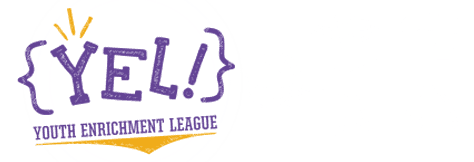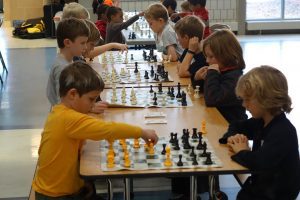Five Components of every {YEL!} chess class

• “What did you learn in chess class today?”
• “You got chess dollars?!!? Awesome. How did you earn them?”
• “Did you play a chess game in class today?”
If you have a child in a YEL chess class, perhaps you’ve asked your child any, if not all of these questions at some point.
Every class YEL teaches, whether it is chess, LEGOs, guitar, fencing, sewing or any other YEL class, has one mission:
• To engage youth to THINK, LEARN and PLAY WELL.
Every chess class has five components every student should get out of each class. We call this our recipe for success in chess. The five components of each chess class are:
• Teach It!
• Practice It!
• Puzzle It!
• Play It!
• Chess Dollars and FUN!
TEACH IT!
The Teach It! time should feel like The Price is Right…or any other game show. Kids should be pumping their hands in the air, anxious to answer the next puzzle and they are rewarded with a Chess Dollar for answering the teacher’s questions.
YEL instructors are trained to give a 10-15 minute lecture at the beginning of each class. These lectures can be as basic as piece movement or castling and as complex as Queen Sacrifices, the Fried Liver Attack or Rooks on the seventh rank. Each lesson is designed for multiple levels in the same classroom. Each lecture starts with basic positions and gets progressively more difficult. For instance, if we are teaching the King & Queen versus King, the teacher would start with a basic puzzle.
From here, the teacher asks, “What are white’s available checks?” We want the Teach It! time to be collaborative learning experience for everyone, so the teacher will take all sorts of answers. Some things students might say are: Qc5+, Qe7+, Qg7+, etc. The teacher discusses each answer:
1. Qc5+…Ke8 or
1. Qe7+…Kg8
Then we focus in on the best answer, or answers. In this case, there are actually four moves that lead to mate-in-one. Can you find all of them?
Yes, 1. Qf7# is one option. Good job! Chess Dollar for you!
What are the others? Scroll down to see.
Yes, 1. Qd8# works. Of course 1. Qc8# and 1. Qb8# also work.
Great job! $1 Chess Dollar for you.
After thoroughly discussing the basics, YEL teachers go over more difficult puzzles (See your child’s Lesson 2.06 worksheet for more KQ vs K puzzles…NOTE: It’s possible your child hasn’t had this lesson yet as it is usually the 12th lesson of our system). Then it is on to…
PRACTICE IT!
Practice It! time is an opportunity for students to drill the concept a bit more so they understand when they come across it on the chess board. For the above chess lesson, we ask the students to set up the following position on their board:

White is up a Queen in the endgame. A winning position for any player who has practiced this lesson. From here White needs to simply follow the recipe for a win: 1) Pick a jail; 2) Create a box; 3) Copy Cat; 4) Lock the King in jail; 5) Bring in YOUR King and 6) Checkmate with Queen.
You did it! Chess Dollar for you!
Once they do this, they are asked to switch places and have the the other player win from the same position. The instructor is constantly canvassing the room and coaching any struggling students.
Students who finish early can move on to…
PUZZLE IT!
During Puzzle It! time, students are given a sheet of 12-24 puzzles varying in difficulty. They can solve as many puzzles as time permits. The YEL Chess Coach is still canvassing the room, looking for opportunities to help each child.
You solved 6 puzzles? Awesome! Here are $2 chess dollars for you!
After a child is finished with puzzles, or about 10 minutes into Puzzle It! time, they are paired up with a student of similar age and skill for…
PLAY IT!
This is where the rubber meets the road. It’s where the PLAY WELL component of our mission comes in. Students are given 20-30 minutes of playing time each week. They pair up with a classmate, friend or new opponent, shake hands, say “Have a good game.” and play chess. Our coaches continue to canvas the room, but we have found varying coaches have varied approaches.
• Coach A may coach during each game. Find suggested moves, whisper a strategy in one player’s ear, encourage players that are struggling, etc.
• Coach B may treat Play It! time as a tournament, where there is no coaching during games. Encourage students? For sure: i.e. “Keep working hard, a solution might present itself.”, “Don’t give up. There is still a lot to learn.”! But coaching happens after the game is complete. We have found both approaches are highly effective and which style is really a matter of personal coaching style.
Chess Dollars and Fun!
You’ve seen chess dollars referenced throughout this article. The chess dollars function as merit points based on a student’s work and focus in that day’s chess class. Students should receive between $5-10 chess dollars per day. Students can earn chess dollars (as mentioned above) in a number of ways:
• Answering questions during the Teach It! lecture time.
• Solving positions during the Practice It! time.
• Solving puzzles during the Puzzle It! time.
• Creating checkmate, castling, finding a useful Pin or Fork or other tactical gains during the Play It! portion of class.
• Playing hard, keeping your focus and helping your teammates in class!
As you can see, the Chess Dollars aren’t based solely on winning. And different levels of students can earn different levels of dollars. It’s quite common for a fourth year student to have $300 chess dollars saved up.
What are the chess dollars used for? Chess PRIZES! We’ve got ’em all: Rookie Trophies, Pro, All Star, Expert and Grandmaster trophies too, chess keychains, magnetic chess boards, chess pins, knight erasers, etc., etc.
What else? Chess Dollars are a great way for students to learn how to watch over their money. Maybe even learn a bit about budgeting for the big prize they are saving up for.
All in all, the class is designed for multiple levels of chess students to work at their level for fun, merit and the love of the game.
We hope you consider signing up for a YEL Chess Class or YEL Chess tournament in the future.



